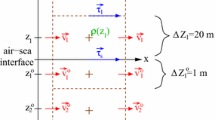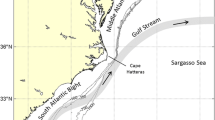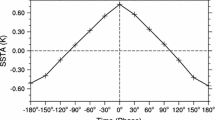Abstract
An eigen analysis of the equatorial air—sea coupled model is carried out to understand the mechanism of the slowly varying mode for various zonal phase differences between SST and wind stress. The frequency and growth rate of the slow mode highly depend on the zonal phase difference between SST and wind stress anomalies and the wave scale. For ultra—long waves longer than 20,000 km, the system propagates westward regardless of the position of wind stress. However, for the long waves observed in the Pacific, the slow mode tends to propagate eastward when the SST and wind stress anomalies are close to each other (within a quadrature phase relationship). On the other hand, when the wind stress is located far away from SST, the slow mode tends to propagate westward. The coupled system produces the unstable modes when the westerly (easterly) wind stress is located in the west of warm (cold) SST. It is noted that for the Pacific basin scale, the eastward propagating unstable waves can be produced when the wind stress is located to the west of SST with a few thousand kilometer distance. Also examined in the present study is the relative role of the thermocline displacement and zonal advection effects in determining the propagation and instability of the coupled system.
Similar content being viewed by others
References
An S.-I., and B. Wang, 2000: Interdecadal change of the structure of the ENSO mode and its impact on the ENSO frequency. J. Climate, 13, 2044–2055.
Anderson D. L. T., and J. P. McCreary, 1985: Slowly propagating disturbances in a coupled ocean-atmosphere model. J. Atmos. Sci., 42, 615–629.
Battisti D. S., and A. C. Hirst, 1989: Interannual variability in the tropical atmosphere / ocean system: Influence of the basic state and ocean geometry. J. Atmos. Sci., 46, 1687–1712.
Cane M A., and S. E. Zebiak, 1985: A theory for El Nino and the Southern Oscillation. Science, 228, 1084–1087.
Dewitte B., and C. Perigaud, 1996: El Nino - La Nina events simulated with Cane and Zebiak’s model and observed with satellite or ii situ data, Part II: model forced with observations. J. Climate, 9, 1188–1207.
Hirst A. C, 1986: Unstable and damped equatorial modes in simple coupled ocean-atmosphere models. J. Atmos. Sci, 43, 606–630.
Hirst A. C. 1988: Slow instabilities in tropical ocean basin-global atmosphere models. J. Atmos. Sci., 45, 830–852.
Hoerling M. P., A. Kumar, and M. Zhong, 1997: El Nino, La Nina, and the nonlinearity of their teleconnections. J. Climate, 10, 1769–1786.
Jin F.-F., 1997: An equatorial ocean recharge paradigm for ENSO. Part I: Conceptual model. J. Atmos. Sci., 54, 811–829.
Jin F.-F., and J. D. Neelin, 1993: Modes of interannual tropical ocean-atmosphere interaction - a unified view. Part I: Numerical results. J. Atmos. Sci., 50, 3477–3503.
Kang I.-S., and S.-I. An, 1998: Kelvin and Rossby wave contributions to the SST oscillation of ENSO. J. Climate, 11, 2461–2469.
Kang I.-S., and J.-S. Kug, 2000: An El-Nino prediction system using an intermediate ocean and a statistical at-mosphere. Geophy. Res. Lett.. 27, 1167–1170.
Kirtman B. P., 1997: Oceanic Rossby wave dynamics and the ENSO period in a coupled model. J. Climate, 10, 1690–1704.
Lau K. M., 1981: Oscillations in a simple equatorial climate system. J. Atmos. Sci., 38, 248–261.
Lau N. C, S. G. H. Philander, and M. J. Nath, 1992: Simulation of El Nino /Southern Oscillation phenomena with a low-resolution coupled general circulation model of the global ocean and atmosphere. J. Climate, 5, 284–307.
Meehl G. A., 1990: Seasonal cycle forcing of El Nino-Southern Oscillation in a global coupled ocean-atmosphere GCM. J. Climate, 3, 72–98.
Perigaud C, and B. Dewitte, 1996: El Nino-La Nina events simulated with Cane and Zebiak’s model and observed with satellite or in situ data, Part I: model data comparison. J. Climate, 9, 66–84.
Wakata, Y., and E. S. Sarachik, 1991: Unstable coupled atmosphere-ocean basin modes in the presence of a spatially varying basic state. J. Atmos. Sci., 48, 2060–2077.
Yamagata T., 1985: Stability of a simple air-sea coupled model in the tropics. Coupled Ocean-Atmosphere Models. J. C. Nihoul, Ed., Elsevier Oceanography Series No. 40, 637–657.
Zebiak S. E., and M. A. Cane, 1987: A model El Nino-Southern Oscillation. Mon. Wea, Rev,, 115, 2262–2278.
Author information
Authors and Affiliations
Corresponding author
Additional information
Soon-Il An was supported by Frontier Research System for Global Change through its sponsorship of International Pacific Research Center, and In-Sik Kang was supported by the Brain Korea 21 Project and the SRC project of Korean Science and Technology Foundation. The authors thank Diane Henderson for her careful reading and editing of the manuscript. SOEST Contribution Number is 5285. IPRC contribution number is IPRC-63.
Rights and permissions
About this article
Cite this article
An, SI., Kang, IS. Sensitivity of the equatorial air—sea coupled system to the zonal phase difference between SST and wind stress. Adv. Atmos. Sci. 18, 155–165 (2001). https://doi.org/10.1007/s00376-001-0010-8
Received:
Revised:
Issue Date:
DOI: https://doi.org/10.1007/s00376-001-0010-8




